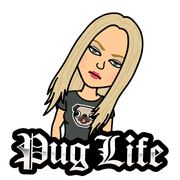|
By Katy Cable/TWR A 3 min. Read 💕 February is Doggy Dental Health Care month and believe it or not, neglecting this crucial element of your pup’s overall health can be deadly. Or, lead to a host of other major health issues, here are some very important tips and facts for you to “brush-up” on: I used to think people who brushed their dog's teeth were being a tad obsessive. Then my vet informed me they pulled 13 teeth out of my Pug Raisin's mouth and handed me a bill large enough for me to sink my own teeth into. Right then and there I realized how important doggie dental care is. Unless you're a three-year-old child, you probably wouldn't dream of going day's on end without brushing your teeth. Believe it or not, your dog shouldn't either. When plaque is allowed to accumulate on your dog's teeth, within a few days it hardens into tartar. Tartar adheres to the teeth and irritates the gums. Irritated gums result in an inflammatory condition called gingivitis. Dogs with gingivitis have red rather than pink gums, and stinky breath. If the tartar isn't removed, it builds up under the gums, eventually causing them to pull away from the teeth. This creates small pockets in the gum tissue that trap additional bacteria in the mouth. Once things progress to this stage, your dog will have developed an irreversible condition called periodontal disease, which not only causes considerable pain, but can also result in abscesses, infections, loose teeth, and bone loss. But here's what's really shocking: Should your dog develop periodontal disease, the surface of his gums will be weakened, which can allow mouth bacteria to invade the bloodstream and travel throughout the body. If their immune system doesn't kill off the circulating bacteria, it can reach the heart and infect it with a multitude of serious issues. Some types of bacteria found in the mouths of dogs produce sticky proteins that can adhere to artery walls, causing them to thicken. Mouth bacteria are also known to promote the formation of blood clots that can severely damage the heart. If that's not bad enough, studies have linked periodontal disease in both humans and pets to systemic diseases of the kidneys, liver, and lungs. It can also result in diabetes complications, problems during pregnancy, and even cancer. These serious health problems can either develop or be worsened as inflamed or bleeding gum tissue allows harmful oral bacteria to filter into the bloodstream quicker than a pug can devour a meal. In addition to systemic diseases, infections in the mouth often create other problems including tooth root abscesses, jaw fractures, nasal infections, and in extreme cases, eye loss and oral cancer. If your dog is lucky they may get by with a simple cavity or chipped tooth. That probably scared you enough to start looking for a new doggie toothbrush. And that's good news since most of these conditions can be avoided or greatly improved once good oral hygiene has begun and any dental disease has been resolved. As you can see, your dog's oral hygiene is much more than just an obsessive grooming afterthought. It's an extremely important factor in maintaining your dog's health and longevity. I suggest you begin by talking to your vet and getting a thorough evaluation of your dog's teeth, gums and mouth. In my case, I began daily brushing the second I brought home my new Pug Olive. Now she’s 6 years old and still hasn’t needed professional dental cleanings. Her teeth look great. But with my first Pug Raisin, I learned the hard way. He needed twice-yearly cleanings and major oral surgery to repair just a few years of neglect. Pugs and other "flat-nosed" breeds come genetically disadvantaged in terms of dental health. They seem to have teeth settled in the far reaches of their throats. Not only are they hard to find, but they’re also even harder to clean. Their cramped, flat muzzles and the shape of their mouths make properly cleaning back molars about as easy as resisting homemade brownies straight out of the oven. Again, your vet can recommend possibly adding some tartar-removing sprays, (or check out TEEF) and other products which might be useful. Hopefully, you can get things under control and deep cleaning with anesthesia will not be necessary. Here are a few simple tips for keeping your pet's mouth healthy and introducing the toothbrush:
The next step is to use a safe, natural dental cleaning product designed for pets and apply a small amount to the gauze before you rub your dog's teeth. I am a fan of Oxyfresh products. With minimal time and effort, all that brown gunk around the back teeth comes right off and usually professional cleanings can be avoided. If you don't have canine toothpaste, you can use organic coconut oil. Once they get used to this, you can progress to either a finger brush or a soft toothbrush the right size for their mouth. Remember, the more rubbing and brushing your pet will allow, the more quickly you'll see results, and the easier it will be to maintain dental health. If your furry companion is highly resistant to having their teeth rubbed or brushed, or, in the case of a new rescue/shelter dog that comes with a mouth needing major attention, you can try a new, amazing product called TEEF. Simply add a small pinch of this all-natural, tasteless, odorless powder to your dog’s water each day and BAM! A clean mouth, fresh breath, whiter teeth, and NO MORE harmful bacteria, plaque and tarter. It’s the easiest thing EVER! This product is a game-changer for Pugs or other pets with dental issues. Also, before attempting dental care, consider using CBD treats and oil. This all-natural cannabis works miracles to chill-out an anxious dog. ( Use Code: TWR10 to receive 10% off Paws Effect CBD from my store) ☠️ALERT REGARDING DOGGIE DENTAL TREATS Please be cautious when purchasing doggie dental treats. Many contain harmful if not toxic ingredients. Before You Buy Dental Care Treats, Read The Ingredient List! I see lots of pet parents gravitating to dry kibble and dental treats to keep their dog’s teeth clean. This is a popular misconception. In addition to not containing healthy, species-appropriate ingredients, they are loaded with harmful additives and preservatives. Some of the most popular products such as Milk Bone Brushing Chews and Purina Beneful Healthy Smile Dental Twists contain the synthetic toxic preservatives BHA (butylated hydroxyanisole) and BHT (butylated hydroxytoluene) which are used to prevent fats and oils in food from turning rancid. The U.S. Department of Health and Human Services National Toxicology Program has identified BHA and BHT as cancer-causing agents that consistently produce certain types of tumors in laboratory animals. Unfortunately, the FDA still permits the use of these chemicals as preservatives in food, deeming them "generally recognized as safe" in low doses. In addition, smaller treats that are chewed and swallowed in a matter of seconds provide no real dental benefit for your pet. Remember, even with bones, dental treats, and a healthy diet, it’s still necessary to use TEEF or brush your dog’s teeth. It’s one of the best things you can do to keep your sweetie from becoming “All Bark and No Bite!” 😁 🐾Katy Cable is a former actress appearing in “Back To The Future” and starring in the TV series: “Safe At Home” & “ Fired Up!” In addition to her dog health & lifestyle blog/vlog: The Weekly Runt, (https://www.weeklyrunt.com/) she’s a contributing writer to numerous publications including Thrive Global, & The Huffington Post. Cable lives at the beach with her husband, Rick and her rescue Pug, Olive.🐾 |
PARTNERSHIPS
...Let’s Work Together
I love collaborating with other influencers and brands! Whether you need assistance with social media, creating an unforgettable event or want to be featured in my nationally syndicated blog, I can help. Let’s talk!


